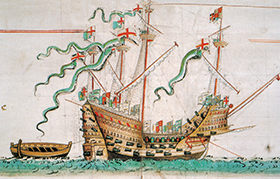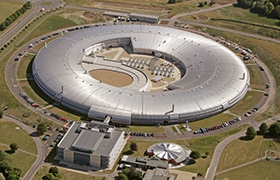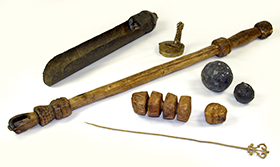The second annual Joint Meeting of the SCI London Regional Group and the Institute of Corrosion, London Branch, was held at SCI on 25 Oct 2018, where two speakers gave some very different perspectives on corrosion.
The first presentation, ‘A Fighting Ship’ was given by Professor Eleanor Schofield, Head of Conservation and Collections Care at the Mary Rose Trust in Portsmouth.
Most of us will be familiar with the story of the recovery of the Mary Rose in 1982, although Professor Schofield began her talk by correcting the too often quoted story that she sank in 1545 on her maiden voyage. In fact, she was built in 1510 and served for 34 years as the flagship of Henry VIII's navy in many battles, particularly in wars against France.

Perhaps less well known is the work in restoring and maintaining over 19,000 artefacts that had also been recovered, including 1,200-plus iron cannonballs.
Left: Mary Rose Painting
Exposure to chlorine in seawater is very damaging to iron when later exposed to air, causing corrosion that can eat away at the metal and weakens its structure – and these had been exposed for hundreds of years.
The conservation team were tasked with finding ways to preserve the cannonballs.
While the cannons themselves were made to last and be used many times, the projectiles were of course only intended for single use, and so their quality and standards of manufacture were greatly inferior.
Initially, researchers attempted to remove chlorine from the cannonballs by soaking them in water with and without chemical treatment. Chlorine reduction by heating in an atmosphere of hydrogen was also attempted. Unfortunately, this did not successfully prevent disintegration when they were later put on display. To better understand this, Professor Schofield established a research project with UCL Archaeology and the UK Diamond Light Source, to investigate what was going on inside the cannonballs.
Diamond Light Source is the UK’s national synchrotron. It works like a giant microscope, harnessing the power of electrons to produce penetrating bright light that scientists can use to study anything from fossils, to jet engines, to viruses and vaccines.

Right: Diamond Light Source Synchrotron
The results of the bright X-rays revealed detailed maps of the elements involved in the corrosive process – an unprecedented insight into conservation on a molecular scale. This crucial information will help to protect these and other artefacts for many decades to come.
The second presentation, ‘Fighting Corrosion’ was given by Jim Glynn, of the Institute of Corrosion, London Branch, and Founding CEO of the coating distribution company Beanny.
Mr Glynn gave an overview of protection methods for in-ground and subsea structures. He concentrated on a ‘dynamic duo’ of protection methods – a suitable protective coating as a first line of defence and, where appropriate, a cathodic protection system to prevent any corrosion occurring at holidays or in areas of coating damage.

Left: Mary Rose Artifacts
Many examples were given where the correct conditions of a good coating and a suitable working cathodic potential were present – but there were many examples where this was unsuccessful, too. These included a pipeline coating that had totally disbonded and broken away from the pipeline. This was caused by a higher potential than required, which generated hydrogen gas on the surface of the pipeline.
Mr Glynn also described thermally-sprayed aluminium (TSA) applications, which are excellent protective coatings when properly applied. The aluminium content can also act as its own in-built cathodic protection anode.
Also presented were the recent case studies of retro-fitting remote anode beds to two North Sea rigs. These rigs had exceeded their design life, but it was decided that the sub-sea structure could be further protected using cathodic protection. One had been fully coated, while the legs on the other had been left bare, but with a built-in corrosion factor that should exceed its expected life. The survey confirmed that both could be successfully protected using the methods adopted in the much deeper waters of the Gulf of Mexico.
The coated structure required 1,000 Amps, while the bare steel legs needed around 7,500 Amps to produce the correct comprehensive negative potentials. The location of the anode sea-beds were also calculated – these high-DC currents were produced by banks of transformer rectifiers connected to an AC mains electrical source.
Dr. Fred Parrett
Treasurer – SCI London Regional Group
